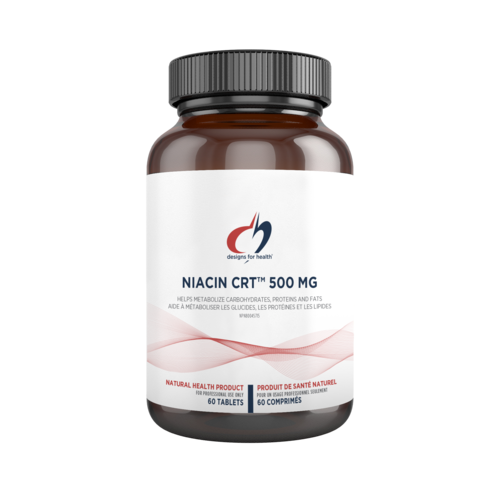Niacin CRT™ offers beneficial doses of niacin (as nicotinic acid) in a unique wax-matrix tablet that utilizes the latest controlled-release technology (CRT) for optimal bioavailability. It is available in controlled release tablets formulated to deliver niacin in a continuous designed release pattern over a six to eight hour period, the transit time through the bowels. Niacin, also known as vitamin B3 or nicotinic acid (NA), is an essential cofactor in several metabolic pathways in the body due to its function as coenzymes NAD (nicotine-adenine dinucleotide) and NADP (nicotine-adenine dinucleotide phosphate) in hundreds of metabolic reactions including oxidation-reduction reactions, mitochondrial aerobic respiration, and cellular energy production. Similarly, niacin, in the form of NAD, is an essential cofactor for the enzymes in the folate/tetrahydrobiopterin and methionine cycles. Niacin receptors are distributed and expressed in immune cells, adipose tissue, and the brain, supporting niacin’s roles in modulating lipolysis in adipocytes and regulating the inflammatory cascade. There are two G-protein-couple membrane receptors that bind NA;2 the high-affinity niacin receptor 1 (NIACR1) is responsible for high-dosage skin flushing, and GRP109A and TRPV1 receptors are responsible for the anti-atherosclerotic effects of NA.3 Studies demonstrate doses >1 g/day exert anti-inflammatory effects via niacin receptor activity, enhance insulin sensitivity, reduce the size of adipocytes, exert anti-atherogenic effects on lipid markers, and increase niacin receptor expression in fat cells.1
In healthy subjects, 2 g extended-release niacin dosed just before a high-fat meal acutely suppressed postprandial triglyceridemia by 33% compared to placebo,4 and similarly, markedly decreased postprandial production of lipoprotein(a) and apolipoproteinB-100 concentrations in statin-treated type 2 diabetics due to niacin’s inhibitory activity on the rate-limiting enzyme that catalyzes the final reaction in triglyceride synthesis, and via upregulation of fatty acid oxidation in the liver.5 Niacin’s lipid-lowering capabilities were discovered in the 1950s in experimental studies when researchers reported nicotinic acid’s ability to lower serum cholesterol and inhibit lipid deposition in both healthy and hypercholesterolemic animals when administered in gram doses.6,7 A meta-analysis showed that high dose niacin supplementation (between 1-3 g per day) administered with or without cholesterol-lowering medication reduced cardiovascular disease (CVD) and coronary heart disease incidences associated with its beneficial effects on inflammatory biomarkers via modulation of NIACR1 receptors.1,8 A systematic review of the literature found that niacin treatment significantly increased serum HDL-cholesterol levels by 21.4% from baseline measures, and was associated with trends towards reduced risk of CVD mortality, heart attack, coronary death, and stroke; however, the results showed no differences in all-cause mortality rates compared to controls.9 In a pilot study of hypoalphalipoproteinemia patients with serum HDL-C levels ≤ 40 mg/dL, extended-release NA treatment significantly increased total HDL cholesterol and phospholipids, HDL2 levels, and HDL particle size, as well as HDL cholesterol efflux and uptake capacity.
Legal Disclaimer
Actual product packaging and materials may contain more and different information than what is shown on our website.
We recommend that you do not rely solely on the information presented and that you always read labels, warnings, and directions before using or consuming a product or Book with one of BodyCrafters Physicians / Naturopathic Doctors or a Certified Natural Product Advisor.





